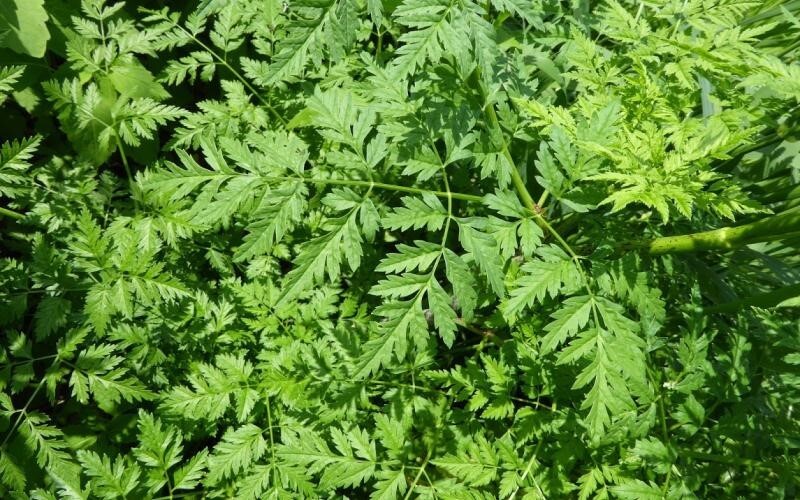|
Having trouble viewing this email? View it as a Web page.
June 3, 2024
June Weed of the Month: Poison Hemlock Noxious Weed Status Change
Poison hemlock sap contains toxins that can be absorbed through skin
Julia Dellick, Minnesota Department of Agriculture
Poison hemlock (Conium maculatum L.), a toxic herbaceous plant, was initially categorized in 2018 as a Prohibited Eradicate species on the Minnesota Noxious Weed List due to its toxicity and limited known range. Prohibited Eradicate species are the highest priority noxious weeds in Minnesota and must be destroyed. They are either not present in Minnesota or are not widely established. Since 2018, surveying and mapping efforts have revealed that poison hemlock is widespread in southern Minnesota, spreading through waterways and rail corridors. Given the continued discovery of new infestations and the increased difficulty in management, poison hemlock was reclassified in 2023 to the Prohibited Control category on the Noxious Weed List.
 Poison hemlock blooms from May to August. It has small white flowers grouped in clusters at the ends of its branches, with each cluster measuring 3-6 inches in diameter.
Download photo
Regulations for Prohibited Control species mandate that efforts must be made to prevent seed from maturing and plants from being dispersed into new areas. There may be no transportation, propagation, or sale of these plants. Failure to comply may result in enforcement action by the county or local municipality.
Poison hemlock is a member of the carrot family and is commonly found on roadsides, in pastures, along streambanks, and in ditches. It is a biennial and produces a low-growing rosette in its first year of growth that matures the following year into a tall flowering stalk growing up to 8 feet. The stems of the plant are hollow, ridged, hairless, and have purple spots/mottles. Its leaves are pinnately compound (smaller leaflets arranged on each side of the leaf’s central stalk) and fernlike, with petioles that clasp to the stem at a node. In late May to August, small white flowers bloom at the tips of branched stems. These flowers are clustered in umbels that are 3 to 6 inches in diameter. After blooming, the plant produces abundant seeds that are flat with ridges and are easily spread by mowing and other equipment.
 Plant leaves are pinnately compound and fernlike.
Download photo
The most effective management techniques to control poison hemlock are mowing and herbicide application. Mowing has the potential to spread seeds, so it must be done properly. Make sure to mow before seeds form to prevent movement of the plant to new locations. Always be sure to clean equipment, clothing, and shoes after moving through an infestation.
Rosettes can be treated in the early spring and fall with herbicide applications. Spring treatments of rosettes should be timed well in advance of flowering, and follow-up treatments may be necessary for several years to exhaust the seedbank. If using herbicide treatments, check with your local University of Minnesota Extension educator, co-op, or certified landscape care expert for assistance and recommendations. There are several businesses throughout the state with certified herbicide applicators that can be hired to perform chemical applications.
 Poison hemlock appears as a low-growing rosette in its first year of growth.
Download photo
Always be careful when working in and around poison hemlock as it is highly poisonous to humans and livestock. Do not ingest any part of the plant and wear proper clothing, including gloves, long sleeves, long pants, and closed-toe boots if working in an infestation. Poison hemlock sap contains toxins that can be absorbed through skin. Symptoms of poison hemlock toxicity include: nervous trembling, salivation, pupil dilation, a rapid, weak pulse, and eventually coma or death. For suspected toxicity to people, seek medical care immediately. Minnesota Poison Control System can answer non-emergency questions about poison hemlock toxicity. For suspected toxicity to animals, seek veterinary care immediately.
MEDIA: For more information on Weed of the Month, contact Brittany Raveill, MDA Communications, at brittany.raveill@state.mn.us or 651-201-6131
|